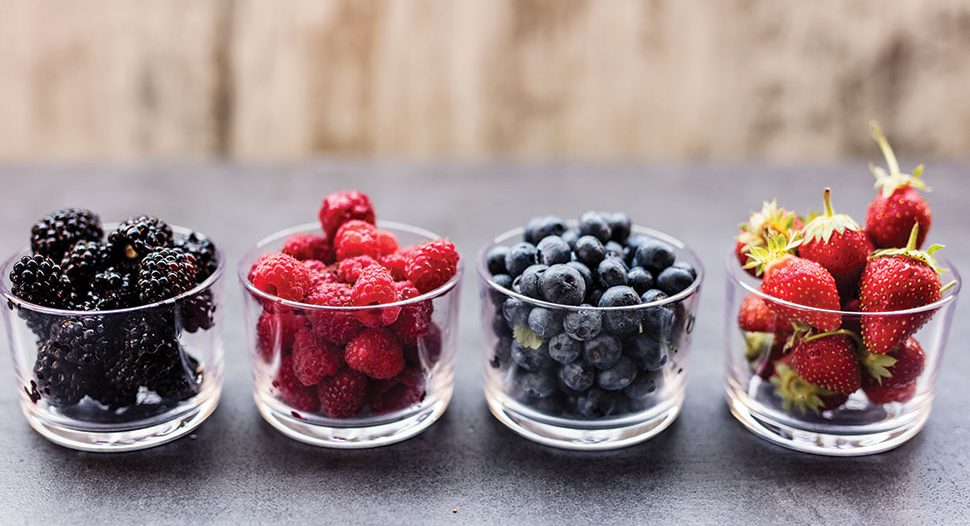Fondazione Edmund Mach (the Trento-based organisation that carries out scientific research, education and training, experimentation, consultancy and business services in the agricultural, agri-food and environmental sectors) is collaborating with VacCAP to develop methodologies for the assessment of taste and texture, considered the fundamental traits by which the quality of new selections of blueberry can be evaluated. The collaboration also involves members of theUSDA and North Carolina State University. The Vaccinium Coordinated Agricultural Project (VacCAP) is a nationally coordinated transdisciplinary project that focuses on addressing the major bottlenecks limiting the growth of the US Vaccinium industry by developing and implementing marker-assisted selection (MAS) capability in breeding programmes.
We often talk about how fruit quality is the key to developing better blueberries. But what does fruit quality actually mean and how is the Vaccinium Agricultural Coordinated Project (VacCAP) team working to improve these characteristics?
"We know that fruit quality is a complex and often elusive concept - encompassing more than just sensory characteristics - where the consumer is satisfied with the product he or she will eat," said Dr Lara Giongo, Co-PI and Head of the Berry Genetics and Breeding Unit at the Edmund Mach Foundation (Italy).
When we talk about fruit quality in blueberry, we mainly refer to texture and flavour. These are the two main traits that Giongo's team is developing methodologies to assess, but they are also looking at the variability of the gene pool that they have available.
"Texture and flavour are linked," said Giongo. "In blueberries, these two parameters are responsible for the quality of the fruit, but they are quite difficult to evaluate objectively. We have to look at sensory analysis from the point of view of understanding consumers' expectations of food."
However, objective evaluation and standardisation of methods for assessing components such as consistency may allow downstream progress in breeding.
Giongo and his team have started to exchange their knowledge in this field - with a focus on the consistency of blueberries- with Dr Penelope Perkins-Veazie, Co-PD, professor at North Carolina State University, and members of the USDA team. At the heart of this exchange are the methodology they have published on how to analyse consistency in blueberry, as well as the standardisation methods that have been tailor-made for blueberry.
"During pre-harvest we have to have a good control of the propagation system," said Giongo. "We know that in blueberry, having certified plants derived from artificial tissue culture is absolutely crucial for further production. Then there are many environmental factors during harvest that contribute to the post-harvest quality of the fruit which are essentially [related to] temperature and light."
At the Edmund Mach Foundation, Giongo and his team conduct experiments on these factors to improve their plant selections. They examine the cultivation of plants in the open field versus above-ground production, as well as winter production in greenhouses or indoors. This allows them to control the light, temperature and relative humidity to which the fruit is exposed during its development.
In the post-harvest phase, there are other factors that can contribute to the quality and increased value of blueberriesin the market: selection, sanitisation, dosed supply and type of storage are all critical. Giongo's different selections are tested in cold storage, in normal atmosphere, but also in modified atmosphere to separate the effects of storage.
While all these factors are important, Giongo stresses that the most significant factor in post-harvest quality is genotype. The genotype is what makes "most of the impact and difference in blueberry".
"We started this work before VacCAP, but the project helped us a lot to analyse these differences. We saw that the dynamics of the fruit after storage changes a lot and the changes are not in one direction, but can change depending on the genotype," Giongo said. "We can have an improved texture for some genotypes, or a detrimental texture for another genotype. So, getting this kind of high-throughput phenotyping helps us select [unsuitable genotypes] before bringing them to growers."
Giongo notes that the process of determining fruit quality takes place throughout the growing process. The team uses consistency essentially for all their screening of seedlings and the new materials they introduce into assessments. It is a very fast analysis in terms of operation, and they can process a large number of samples in one day during the production season. This helps them to get objective measurements that then help them to select the right material to take forward or set aside.
Structure analysis is also part of the storage studies. The team makes an assessment at harvest of all the fruit and then divides the samples so that the fruit is put in a normal atmosphere or in a modified atmosphere depending on where they see the opportunity for a particular genotype. Then they analyse the data and take a look at where the quality is in terms of consistency.
"This means that we get a segmentation of quality and we deal with those that have a short shelf life in terms of their evaluated characteristics. The ones that have a longer shelf life have a different fate, they might be a bit more suitable for shipping or longer periods of cold storage," Giongo said. "Wefocus on the best selections in each category and then do further phenotyping for the other traits, i.e. flavour or other fruit quality characteristics."
Giongo's team also developed several methodologies and techniques to help distinguish the sub-components of genotypes in order to understand why they fit into their respective segments.
"The [tools] are definitely more complex than the easy-to-use tools that growers can use, but they have helped us understand all the structural profiles of this fruit," Giongo said. "All of these assessments that we've done, and these methodologies that we've developed and published, we've started to correlate these data with simple, low-cost tools that could be much more accessible to growers trying to limit the quality of the fruit in a certain way."
With all this work dedicated to developing methods and facilitating breeding efforts to improve fruit quality traits, Giongo and his team also have to look at what external factors might influence the future of blueberriesand how their work will be affected.
Giongo notes that new technologies throughout the production chain are improving. Energy-saving storage and shipping methods are working towards a point where we can guarantee the consumer a good product with less waste.
"All these different components of the blueberrysupply chain have a role," said Giongo. "The key to the future is to make sure that all this knowledge is connected and disseminated."
Source: VacCAP













